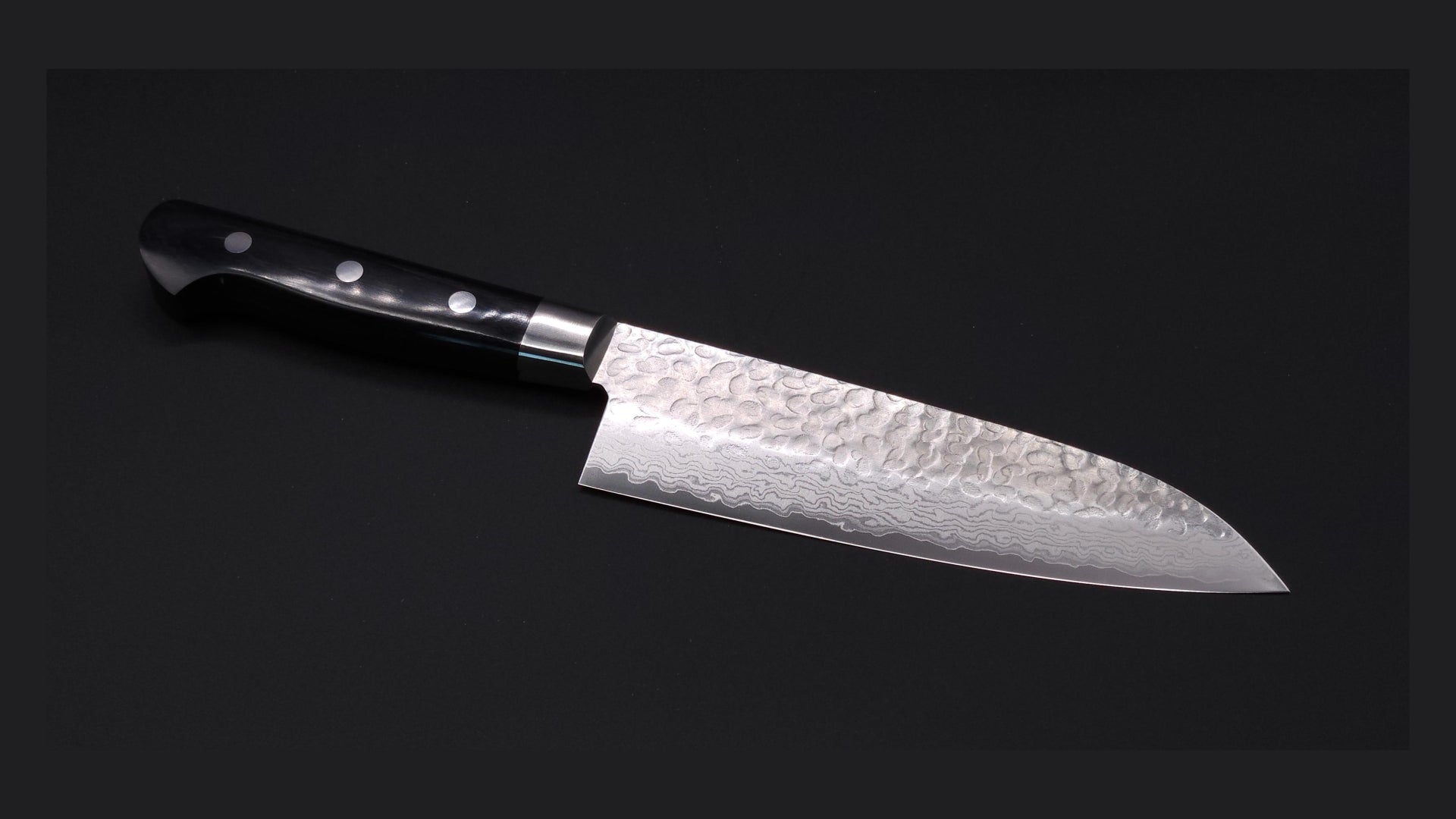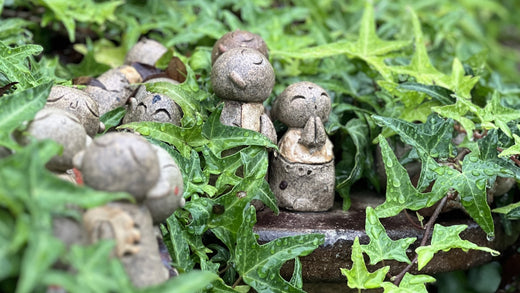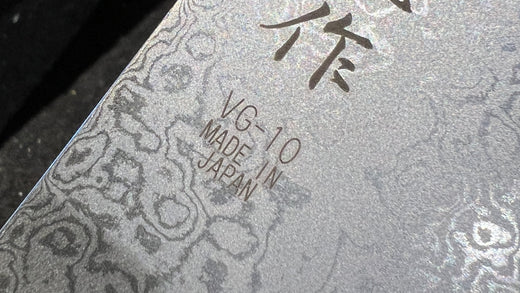
Japanese Knives: A Beginner's Guide
The world of Japanese knives is steeped in tradition, culture, and history.
Perhaps this is why, apart from their legendary sharpness, the highest quality steels used, and the centuries-old forging techniques handed down from generation to generation, Japanese kitchen knives are renowned in the world of haute cuisine and are chosen as indispensable tools by starred chefs and professionals.
In this article, we’ll break down the basics of this world, introduce the unique qualities of Japanese kitchen knives, provide an overview of the models, and explain why they’re a must-have in any kitchen.
What Makes Japanese Knives Unique?
Japanese knives are renowned worldwide for their exceptional sharpness, precision, and craftsmanship. Specifically designed for various tasks, they distinguish themselves from their Western counterparts by their lighter and thinner build, making easily maneuverable.
Japanese knives stand out for their use of high-quality materials and, although stainless steel is common today, they are primarily crafted from high-carbon steel, which enhances their ability to achieve a razor-sharp edge and maintain it for extended periods.
Additionally, some Japanese knives feature a single bevel blade, crucial for achieving clean and precise cuts.
These distinctive attributes establish the Japanese knife as an essential instrument in kitchens, whether professional or domestic.
Historical Background
To better understand why Japanese knifemaking has reached such remarkable heights, a quick look at its history is all it takes.
With a history spanning several centuries, the tradition of Japanese knifemaking actually originated from the forging methods used in the production of samurai swords.
As Japanese society gradually changed from a feudal structure to a more modern and industrialized one, the laws that governed the ownership and sale of Katana (the samurai swords) changed accordingly, significantly limiting the sale of swords and causing a natural reconversion of blacksmiths who began to transfer their exceptional forging skills to the production of knives.
As the manufacturing increased nationwide, cities like Sakai (Osaka), Seki (Gifu), and Echizen (Fukui) gained fame as hubs for knife making, each cultivating distinct styles and techniques.
Furthermore, between the 19th and 20th centuries, the knife industry in Japan underwent further evolution with the introduction of new technologies and designs from the West.
Elements like the double-edged blade and riveted handle were gradually incorporated into knife production, shaping the evolution of Japanese knives into the form we recognize today.
The Art of Forging
The craftsmanship behind Japanese knives is a blend of ancient traditions and modern innovations, resulting in tools that are both functional and beautiful. Each knife is a testament to the dedication and skill of the artisans who create them, using techniques that have been perfected over centuries.

Blade forging at Seki, Gifu prefecture.
At the heart of Japanese knife making is the forging process. Now, this process is very complex and delicate, and it would require a separate article to only grasp its main elements.
So, just to give you a general idea, consider that it involves heating high-carbon steel to extreme temperatures and then hammering it into shape.
The repeated heating and hammering align the steel’s grain structure, enhancing its strength and sharpness.
Japanese knife makers employ various techniques to enhance the performance and aesthetics of their knives. One such technique is the creation of “Damascus” steel, achieved by folding multiple layers of steel to form a unique pattern on the blade. This not only enhances the knife’s beauty but also improves its strength and flexibility
Other traditional techniques such as honyaki ( 本焼・forged solely from one type of steel) and kasumi (霞・laminating softer steel with harder steel) are still used today.
After the blade is forged, it goes through a detailed process of shaping and sharpening. Craftsmen employ whetstones with different levels of coarseness to refine the blade to a highly sharp edge. This stage demands great skill and accuracy, as even minor errors could damage the blade irreparably. The ultimate edge is frequently buffed to achieve a reflective, mirror-like finish that showcases the meticulous craftsmanship involved in its making.
The Importance of Steel
A crucial aspect of Japanese knife making lies in the selection of steel, which significantly impacts the final performance of the knife.
High-carbon steel, valued for its exceptional edge retention, is frequently employed, with Aogami (青紙・Blue steel) and Shirogami (白紙・White steel) being the most prevalent types among professionals.
Certain knives are crafted from Tamahagane (玉鋼) steel, which is a high-carbon steel produced using traditional Tatara (鑪) smelting methods originating from Shimane prefecture. This particular steel is highly esteemed for its exceptional purity and strength.
High carbon steel offers optimal sharpness and edge retention but demands meticulous care due to its susceptibility to rust and oxidation. Consequently, using a "traditional" high carbon steel Japanese knife daily can be challenging, especially for non-professional users. Japanese knife craftsmanship also utilizes stainless steel, which, though less edge-retentive than high carbon options, outperforms typical Western knife steels due to its use of harder materials.
Common Japanese stainless steels such as VG-10, VG-1, and AUS 10 strike an excellent balance between hardness and ease of maintenance, making them popular among professionals and enthusiasts alike.
Quality Control
Before a Japanese knife leaves the workshop, it undergoes rigorous quality control checks. Each knife is inspected for balance, sharpness, and overall craftsmanship. Only those that meet the highest standards are deemed worthy of bearing the mark of their maker.
TYPES OF JAPANESE KNIVES
Like previously mentioned, Japanese knives are celebrated for their precision, sharpness, and specialized designs. Each type of knife is crafted for specific culinary tasks, making them indispensable tools in any kitchen.
Here is a detailed list of Japanese knife styles, organized for clarity according to their specific purposes:
ALL PURPOSES KNIVES
Santoku (三徳包丁・Multi-purpose Knife )
The word Santoku means “three virtues” in Japanese, and in the culinary context, it refers to the ability of this knife to be used for cutting three different types of food: meat, fish, and vegetables.
This quality makes the Santoku a versatile, all-purpose knife, allowing it to become the most common type of knife found in both home kitchens and professional settings in Japan.
Santoku knives typically measure between 16 cm (6.3 in) and 18 cm (7 in) in length.
Santoku
Gyuto (牛刀包丁・Chef’s Knife)
The Gyuto is a Japanese chef’s knife influenced by Western design, and compared to the Santoku, it features a longer and narrower blade.
Despite its name implying a focus on meat (literally “beef blade”), the Gyuto is a versatile knife suitable for various ingredients, similar to the Santoku.
Thanks to its long blade, typically ranging from 18 cm (7 in) to 24 cm (9.45 in), it excels in handling larger cuts of food. It also offers flexibility and utility in the kitchen, making it very popular among both professional chefs and home cooks.
Petty (ペティナイフ・Utility Knife)
A compact knife shaped like a smaller version of a chef's knife. Often referred to as a fruit knife, it's commonly perceived as being solely for fruits. However, it can be more convenient than a santoku or chef's knife for cutting small vegetables or meat. It's versatile and can be used for various purposes. The typical blade length is around 10 cm (4in) to 15 cm (5.9 in). It's a great second knife to have after a santoku or chef's knife.
Bunka (文化包丁・Bunka Knife)
During the period of rapid economic growth, as home cooking became more Westernized, the Bunka knife emerged as a hybrid of the Western chef's knife (Gyutō) and the Japanese Nakiri (vegetable) knife. Despite being double-edged like Western knives, it's as thin as a traditional Japanese knife, making it versatile for cutting meat, fish, and vegetables with a single knife. For this reason, it's often referred to as "universal" knife (or sometimes simply grouped under the Santoku category)
Kiritsuke (切付包丁・Kiritsuke Bōchō)
The Kiritsuke stands out as a rare, versatile Japanese-style knife, combining elements of both the Yanagiba (traditionally used for slicing raw fish for sashimi) and the Usuba (a knife designed for vegetables). This distinctive blade features a lengthy Yanagiba-like blade and a straight cutting edge akin to the Usuba, resulting in a dual-purpose design. It excels as a vegetable knife for precise cutting and as a raw fish slicer with its ability to make clean, effortless cuts.
KNIVES FOR HANDLING FISH
Deba (出刃包丁・Butcher’s Knife)
The Deba knife is a traditional Japanese blade that has been used since the Edo period, primarily for filleting fish. Available in diverse sizes tailored to fish dimensions, the most common range spans from approximately 15 cm (5.9 in) to 18 cm (7 in).
Recognizable for its robust build and weightier profile compared to other knives, the Deba features a typically single-beveled blade crafted predominantly from carbon steel rather than stainless steel.
Aideba (相出刃包丁・Thinned Deba Knife)
The Aideba is a variation of the traditional Deba knife designed with a lighter and thinner blade, making it more manageable for novice users as well as professionals.
Unagi Saki Hōchō (鰻裂包丁・Eel knife)
The Unagi Knife is specifically designed for filleting eels.
There are various types of it such as Kanto-style (江戸裂 - Edozaki), Kansai-style (鳗裂 - Unagisaki), and Nagoya-style (名古屋裂 - Nagoyasaki).
Honekiri Hochou (骨切り包丁・Boning Knife)
A Honekiri is a type of Japanese knife used for cutting fish with fine bones, such as pike conger.
Mioroshi (身卸包丁・Mioroshi Knife)
Mioroshi is a versatile knife that combines the best features of a Deba and a sashimi knife. With just this one knife, you can process an entire fish, from filleting to slicing. It's the ultimate all-purpose knife for fish.
Ajikiri (鯵切包丁 ・Ajikiri Bōchō)
A compact and finely crafted knife tailored for filleting and preparing small fish like horse mackerel (aji). Ajikiri blades are characterized by their slender profile, ideal for precise and agile handling in professional settings.
Maguro Bochou (マグロ包丁・Tuna Knife)
This is a lengthy, specialized blade employed in the filleting of tuna, commonly showcased during tuna dissection presentations.
KNIVES FOR PULLING AND CUTTING SUSHI AND SASHIMI
Yanagiba (柳刃包丁・Sushi/Sashimi Knife)
Yanagiba Knife, also known as a sashimi knife, is used for slicing fish into thin slices for sashimi.
The taste of sashimi is greatly influenced by the sharpness of the knife and the beauty of the cut. To achieve a clean, single-stroke cut, the blade is quite long. The single bevel blade length is typically around 18-24 cm (7-9.5 in), but some Yanagiba knives can be as long as 30 cm (11.8 in). Like Deba knives, many Yanagiba knives are made of carbon steel rather than stainless steel because carbon steel provides a superior cutting edge and is easier to sharpen.
Takohiki (蛸引包丁・Takohiki Bōchō)
The Takohiki is a type of Kanto-style sashimi knife. Unlike the Yanagiba knife, which has a pointed tip, the Takohiki knife has a square-shaped tip. Despite its name (tako means octopus), it's used for slicing various types of fish, not just octopus.
Fuguhiki (ふぐ引き包丁・Fuguhiki Bōchō)
The Fuguhiki knife is slimmer and lighter compared to both the Yanagiba and the Takobiki. It is specifically designed for slicing sashimi, particularly Pufferfish (Fugu), which has dense meat that requires very thin slicing. This knife is favored by professionals for its precision in this delicate task.
Kiritsuke Yanagiba (切付柳刃包丁)
The Kiritsuke Yanagiba is specifically designed for slicing large slabs of salmon, tuna, and other fish to prepare sashimi in Japanese cuisine. This knife utilizes the sharp point of a yanagiba knife, which is a characteristic of the Kiritsuke knife, which has been popular mainly in the Kanto region as an all-purpose knife for Japanese cuisine. By making it into a cutting type, there is a stiffness near the tip, which creates a sense of stability, making it a highly versatile Yanagiba knife. Moreover, its distinct shape adds visual appeal, making it a fascinating choice for professional chefs.
Unlike its traditional Yanagiba counterpart, the Kiritsuke Yanagiba stands out with its Kiritsuke-style tip, which is more angular and pointed, tapering thinner towards the blade's end. This feature enhances precision cutting and enables delicate knife work, distinguishing it from a standard Yanagiba knife.
KNIVES FOR MEAT
Sujihiki (筋引包丁・Slicer)
The Sujihiki is a type of Japanese kitchen knife primarily used for cutting meat.
Its long, thin blade makes it ideal for tasks such as slicing large blocks of meat and removing sinew. The slender shape also allows for curved cuts and makes it versatile for various butchering tasks.
Due to its long and thin blade, many chefs also use it for slicing sashimi, similar to a Yanagiba knife.
Honesuki / Garasuki (骨スキ包丁 / ガラスキ・Boning Knife)
Honesuki and Garasuki are knives designed specifically for removing meat from bones, known as boning knives internationally. Their distinctive Japanese shape integrates traditional Japanese knife craftsmanship, featuring a single-beveled edge. This design enhances their versatility, particularly in tasks like fish preparation.
The primary distinction between Honesuki and Garasuki knives lies in their size; the Garasuki boasts a more substantial blade of 19 cm (7.5 in) compared to the Honesuki's more modest 14 to 15cm (5.5-5.9).
Additionally, these blades are crafted to be thicker than a Gyuto, enhancing their durability and reducing the likelihood of breakage upon contact with bones. They are predominantly utilized in the meticulous process of deboning poultry, allowing for a clean separation of meat from bone. This makes them an essential tool for chefs who frequently prepare meat dishes requiring precision.
KNIVES FOR VEGETABLES
Nakiri (菜切り包丁・Vegetable Knife)
The Nakiri knife is a traditional Japanese knife specifically designed for cutting vegetables. As a double-edged knife, it's well-suited for slicing, dicing, and chopping large vegetables with its straight blade. Before the modern era when meat consumption was less common in Japan, the Nakiri knife was the primary kitchen tool.
Usuba (薄刃包丁・Professional’s Vegetable Knife)
Usuba knives are essential tools in Japanese culinary arts, employed for precision cutting, chopping, and peeling vegetables. Their exceptionally thin blades enable delicate slicing, achieving paper-thin cuts, such as with turnips. While mastering their use demands precision, they greatly enhance a chef's culinary repertoire, enabling diverse cooking techniques and food preparations. With practice, these knives also excel in thinly slicing various other ingredients, making them indispensable for professional chefs.
KNIVES FOR SPECIAL USE
Kawamuki (皮むき包丁・peeling knife)
This knife is specifically crafted for delicate jobs like artistic vegetable carving, precise shaving, effortless slicing, meticulous peeling, intricate hollowing, katsuramuki (桂むき・a specific peeling technique), and precise beveling.
Funayuki (舟行包丁・fisherman knife)
A representative type of Tosa blade. This knife was created for fishermen to use for cooking on boats, and it is used for filleting fish and cutting vegetables. Known as an all-purpose knife for fishermen, it has a similar shape to a Deba knife and is therefore convenient for filleting fish. Because it is thinner than a Deba knife, it is easy to use for various tasks, and it is easier to fillet small fish with this knife than with a Deba knife.
Sushikiri (寿司切り包丁 ・Sushikiri Bōchō)
The Sushikiri knife is specifically designed for slicing maki-zushi (巻き寿司) and is favored by professionals.
Chuka (中華包丁・Chinese Cleaver)
A multi-purpose Chinese-style knife ideal for preparing various ingredients such as meat, fish, and vegetables.
Menkiri Hōchō (麺切り包丁・ Noodle-cutting knife)
A specialized knife indispensable for cutting noodles such as soba and udon.
Reitou Bōchō (冷凍包丁・Frozen Food Knife)
This knife is specifically designed to cut frozen foods without damaging the blade.
If you try to cut frozen foods with a regular knife, not only will it be difficult to cut, but the blade may also chip. A frozen food knife is essential for cutting frozen items. It has a serrated edge similar to a saw, and you cut by moving it back and forth in a sawing motion. Due to its similarity in shape to a bread knife, it can also be used as a substitute for a bread knife.
Pankiri Hōchō (パン切り包丁・ Bread knife)
A bread knife is purpose-built to slice through bread without squashing it, including softer varieties. Typically, these knives have a serrated edge similar to a saw, allowing them to cut through bread by sawing back and forth. Due to the diversity of bread textures, ranging from crusty French loaves to tender sandwich bread, there are different kinds of bread knives tailored to specific needs.
A lifetime choice
Thanks to the high-quality materials and expert craftsmanship, Japanese knives are incredibly durable. With proper care and maintenance, these knives can last a lifetime, making them a worthwhile investment for any kitchen.
So….to wrap it up
Japanese knives are more than just kitchen tools; they are a blend of art, tradition, and unparalleled functionality. From their superior sharpness and exceptional craftsmanship to their lightweight design and aesthetic appeal, Japanese knives offer a unique culinary experience that can elevate your cooking to new heights. Whether you’re a professional chef or a home cook, investing in a Japanese knife is a decision you won’t regret.
By understanding the history, types, and care of these remarkable knives, you can fully appreciate their value and performance. Remember, the right knife can make all the difference in your kitchen, transforming everyday cooking tasks into a joy.
Ready to Experience the Precision of Japanese Knives?
Don’t miss out on the opportunity to own a piece of this rich tradition. Visit our Shopify store today to explore our curated collection of authentic Japanese knives. Whether you’re looking for a versatile Gyuto, a precise Nakiri, or a specialized Yanagiba, we have the perfect knife to suit your needs.
Elevate your culinary skills and experience the art of Japanese craftsmanship firsthand. Shop now and bring the precision of Japanese knives into your kitchen!



